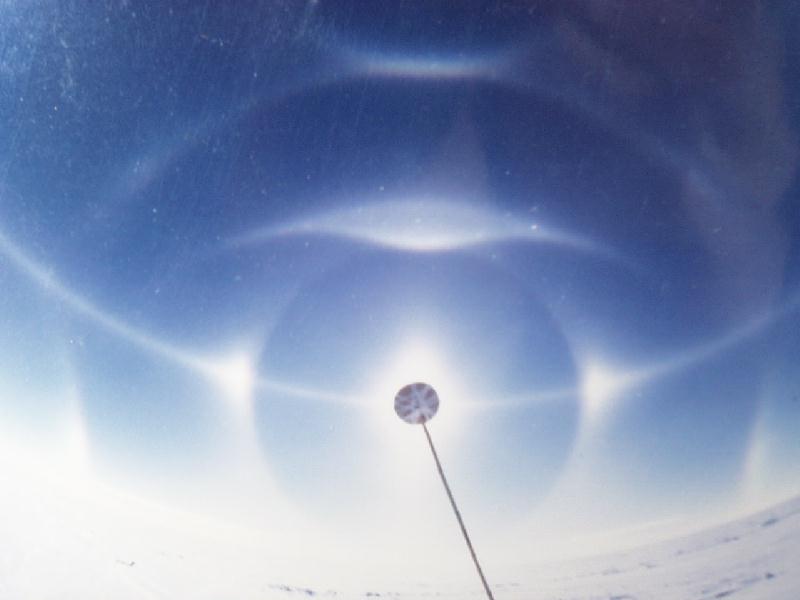


Jesus and nine of the Twelve Apostles depicted with “Floating” disk haloes in perspective (detail from The Tribute Money, illustrating Matthew 17:24-27, by Masaccio, 1424, Brancacci Chapel).
-
Halos (ἅλως; also known as a nimbus or Gloriole), also known as icebows, is a ring of light that surrounds an object. It is optical phenomena that appear near or around the Sun or Moon, and sometimes near other strong light sources such as street lights. Halos are not purely daytime happenings. Look for them whenever a bright moon is veiled by thin cirrus cloud. A full or nearly full moon is best.
There are many types of optical halos, but they are mostly caused by ice crystals in cold cirrus clouds located high (5–10 km, or 3–6 miles) in the upper troposphere. The particular shape and orientation of the crystals is responsible for the type of halo observed. Light is reflected and refracted by the ice crystals and may split up into colors because of dispersion, similarly to the rainbow.
Sometimes in very cold weather optical halos are formed by crystals close to ground level, called diamond dust. The crystals behave like jewels, refracting and reflecting sunlight between their faces, sending shafts of light in particular directions.
Atmospheric phenomena such as halos were used as an empirical means of weather forecasting before meteorology was developed. Other common optical phenomena involving water droplets rather than ice crystals include the glory and the rainbow.
22º halos often encircle the moon. More rarely, because the moon is relatively dim, it is possible to see moon dogs and other halos. Colors are faint or non-existent because their light is barely strong enough to excite the color sensors of our eyes.
Much smaller colored rings sometimes surround the moon. These are not a halo but a corona produced by the diffraction of light by the water droplets of clouds. And of course moonlight creates a rainbow although to the unaided eye it is usually a wan creature devoid of color.
An aureola or aureole (diminutive of Latin aurea, “golden”) is the radiance of luminous cloud which, in paintings of sacred personages, surrounds the whole figure. In the earliest periods of Christian art it was confined to the figures of the persons of the Christian Godhead, but it was afterwards extended to the Virgin Mary and to several of the saints.
The aureola, when enveloping the whole body, generally appears oval or elliptical in form, but occasionally depicted as circular, vesica piscis, or quatrefoil. When it appears merely as a luminous disk round the head, it is called specifically a halo or nimbus, while the combination of nimbus and aureole is called a glory.
The strict distinction between nimbus and aureole is not commonly maintained, and the latter term is most frequently used to denote the radiance round the heads of saints, angels or Persons of the Trinity.
A halo (from Greek ἅλως, halōs; also known as a nimbus, aureole, glory, or gloriole) is a ring of light that surrounds a person in art. They have been used in the iconography of many religions to indicate holy or sacred figures, and have at various periods also been used in images of rulers or heroes.
In the sacred art of Ancient Greece, Ancient Rome, Hinduism, Buddhism, Islam and Christianity, among other religions, sacred persons may be depicted with a halo in the form of a circular glow, or in Asian art flames, around the head, or around the whole body, this last often called a mandorla.
Halos may be shown as almost any colour, but as they represent light are most often depicted as golden, yellow, white, or red when flames are depicted.
In parapsychology and many forms of spiritual practice, an aura is a field of subtle, luminous radiation surrounding a person or object (like the halo or aureola in religious art).
The depiction of such an aura often connotes a person of particular power or holiness. It is said that all living things (including humans) and all objects manifest such an aura. Often it is held to be perceptible, whether spontaneously or with practice: such perception is at times linked with the third eye of Indian spirituality.
Various writers associate various personality traits with the colors of different layers of the aura. It has also been described as a map of the thoughts and feelings surrounding a person.
Filed under: Uncategorized



















